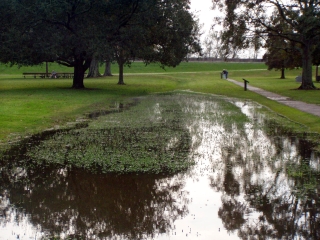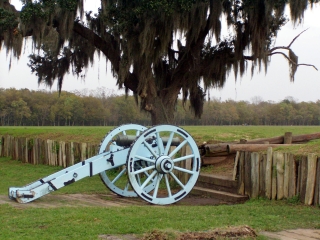Chalmette, La.
NPS Website; Local Website
WHAT IS IT?
One of six separate National Park Sites dedicated to preserving the “natural and cultural resources of the Mississippi Delta region”. This Site commemorates the January 8, 1815 Battle of New Orleans. The Chalmette Battlefield became a National Park Site in 1939 and a part of the newly formed Jean Lafitte NHP in 1978.
 BEAUTY (3/10)
BEAUTY (3/10)The Battlefield is a flat open field of wet grass about the size of a few football fields. The Mississippi River borders the Park to the south but is visible only once you climb the levee. A once impassable swamp (now there is Louisiana Route 46) lies about a half mile north of the River. The Battlefield Road to the Visitor Center marks the defense line of Andrew Jackson’s men.
The geography of the Site itself is no different than it was 200 years ago except for the Visitor Center, the Chalmette Monument and a 19th Century plantation home. Nowadays though, the horizon consists of factories and the burning towers of numerous oil refineries.
HISTORICAL INTEREST (8/10)
The Battle of New Orleans certainly ranks among the most important ever fought on American soil. Much is made of the fact that the Battle occurred after the approval of the Treaty of Ghent that technically the War of 1812 had ended. Even so, the British soldiers knew of the Treaty and were still under orders to take New Orleans. Had they been successful, we find it hard to believe that they would have peaceably returned the Crescent City and, in turn, control of the Mississippi River. Andrew Jackson’s victory marked the final ejection of the British from American soil. It signaled our complete independence and emergence onto the international scene. The Battle also propelled Andrew Jackson to national prominence and onto a straight shot towards the presidency.
CROWDS (7/10)
It was nice to see a large crowd of visitors at Chalmette, both auto passengers and those arriving on the Creole Queen riverboat.
EASE OF USE/ACCESS (3/5)
We had a harder time getting to the Site than originally thought. The Battlefield is six long miles east of New Orleans and Interstate 10, Exit 236. Those six miles along the St. Bernard Highway (Louisiana Route 46) took us at least a half hour to traverse. You name it, we ran into it. Traffic lights, open drawbridge and a train that was inexplicably going forward and then reversing over and over again. Exiting was much easier as we quickly escaped north on Route 47 and hopped onto Interstate 510.
 CONCESSIONS/BOOKSTORE (3/5)
CONCESSIONS/BOOKSTORE (3/5)An under whelming selection of War of 1812 related books is coupled with the surprisingly few books concerning Andrew Jackson. We wished that there had been a better group of books for sale but are unsure if the books we desire even exist. Scholars and publishers seem to have forgotten about Old Hickory and our nation’s second war.
COSTS (4/5)
The Site is free.
RANGER/GUIDE TO TOURIST RATIO (3/5)
A Ranger was stationed at the Visitors Center but computer issues and a person there trying to solve them were taking up much of his time. A friendly volunteer entertained our queries about more Andrew Jackson books. Mostly, “Do you have one more substantial than this one, but not as voluminous as those?” Another Ranger appeared for the 2:45 pm tour, time perfectly for the arrival of the riverboat.
TOURS/CLASSES (7/10)
The Site’s introductory video is extremely helpful, short and sweet even though it was done ages ago. We left with a perfect mental picture of how and why the Battle was fought. A Ranger talk in front of the Beauregard House filled in answered all further questions. Both the video and the Ranger did a good job of placing the fight in the context of the War of 1812 and in refreshing our memories of incidents often skimmed over in history class.
FUN (7/10)
My, my, my have things changed. Just two months ago, we stormed out of the Grand Canyon ready for more exercise. In the meantime, Las Vegas buffets, Texas bar-be-que, and Cajun delights have made us soft. We ran up the spiral staircase of the Chalmette Monument thinking we were still in shape. Once we reached the top, we were panting and light-headed. One of us complained about sore calves for a good many days after our visit. At the same time, it was fun to travel upward in this unbearably flat landscape.
 It is easy to imagine to bloody slaughter that occurred here at Chalmette because the NPS does such a good job explaining the geography of the battleground. Because of the River and the swamp, there was only one narrow corridor, less than 50 feet wide, in the entirety of Louisiana for the British to pass through on their way to New Orleans. When you stand in this area, the military stratagem becomes clear. It feels good when history makes sense but it is hard to be anything but solemn when you realize that over 2,000 British soldiers died here in a span of two hours.
It is easy to imagine to bloody slaughter that occurred here at Chalmette because the NPS does such a good job explaining the geography of the battleground. Because of the River and the swamp, there was only one narrow corridor, less than 50 feet wide, in the entirety of Louisiana for the British to pass through on their way to New Orleans. When you stand in this area, the military stratagem becomes clear. It feels good when history makes sense but it is hard to be anything but solemn when you realize that over 2,000 British soldiers died here in a span of two hours.WOULD WE RECOMMEND? (7/10)
Yes. It is an important historical place in American history and the Site does a good job in explaining what happened. We defy you to visit Chalmette without having the Johnny Horton song, The Battle of New Orleans, echo through your head.
TOTAL 52/80
www.usa-c2c.com
© 2004-06